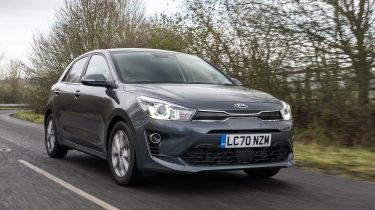New Kia Rio 2017 review
All-new version of the Kia Rio supermini arrives with its sights set on the Ford Fiesta and VW Polo
In isolation the new Kia Rio is a capable supermini, thanks to a neatly designed interior, range of efficient engines and big luggage area. Unfortunately, it’s entering a market with many excellent competitors that beat it in virtually every area, so it’s a tough one to recommend. If you love driving, the Ford Fiesta is better. If it’s comfort and refinement you need, go for the Volkswagen Polo. And if practicality is most important for you, the Honda Jazz has more space.
With the likes of the Volkswagen Polo, Ford Fiesta and Vauxhall Corsa fighting it out for the supermini crown, it’s easy to forget that the efficient, practical and sensible Kia Rio even exists. Now there’s a new model on sale – but Kia hasn’t made it that much easier to remember.
While the old model had a few interesting design touches, such as the ‘tiger nose’ grille and sharp front bumper, this newcomer features a more conservative design. Even the ‘tiger nose’, which is now a single piece of plastic and not a grille at all, doesn’t help the Rio to stand out.
The large lower grille and headlights are the design highlights, as neither the car’s profile nor its rear end stand out from other models in this class. That’s a real shame, as much of Kia’s modern range is distinctive and handsome. While the Rio isn’t ugly, it’s simply a bit dull to look at.
More reviews
• Best superminis on sale right now
Things improve when you hop inside, as the dashboard design is pretty good. The seven-inch touchscreen infotainment system fitted to our test car looks great and is responsive, and there are enough buttons to easily control the air-con and media functions without looking cluttered.
Although the cabin materials look solid, they’re not as high quality as in rivals such as the Polo. There are a few soft-touch areas, but while the interior looks upmarket in pictures, in reality it doesn’t feel as posh as the VW, or even the new Nissan Micra. It’s a step up from the previous model, but not quite enough to match its main rivals.
In fact, that’s pretty much how we’d describe the new Rio on the whole; while it’s moved on from its ageing predecessor, it simply can’t match similar cars in key areas. The new 1.0-litre three-cylinder engine, for example, is a great unit; it feels punchy, is economical and has an enjoyable, thrummy note. But the same-capacity turbos in the Polo, Corsa and Fiesta feel more flexible, are more fun and match the Kia’s economy.
The Rio manages 62.8mpg – competitive with the Fiesta 1.0 EcoBoost’s 65.7mpg – and emits 102g/km of CO2, just behind the 99g/km Ford. Yet while the Kia’s engine is fairly quiet on the road, it can’t match the 89bhp 1.2-litre TSI unit available in the Polo and Fabia. It returns 60.1mpg in both cars and is extremely refined.
Other Rio engines include a 1.25-litre petrol, as well as 1.4 petrol and diesel units. The diesel is top for economy, returning 80.7mpg and emitting 92g/km of CO2 as a 76bhp manual. Avoid the 1.4 petrol automatic if costs are a concern, as it manages only 46.3mpg, which is very disappointing for a small car such as the Rio.
One advantage the Kia does have, though, is the company’s standard seven-year warranty, which is still industry-leading. It covers you for up to 100,000 miles, too.
The 1.0-litre will be the engine of choice for those doing low annual mileage, as well as keen drivers. Unfortunately, the Rio’s dull steering means it’s not particularly fun from behind the wheel, and while the chassis feels more composed than before, it’s still put to shame by the brilliant Fiesta – and the all-new Micra is more fun to drive as well. That’s not something we thought we’d ever be able to say. Our first drive in the Kia included a long motorway run, and while the Rio can’t match the Polo for ride quality and refinement, it’s not uncomfortable. It crashes over bigger bumps, though, and there’s quite a bit of tyre roar at speed.
The driving position is good, with plenty of seat and steering wheel adjustment, although rear legroom is tight when seated behind a tall driver. Headroom in the back is sufficient to allow adults to sit up straight, however.
Boot space is one of the Kia’s real strengths, and the 325-litre luggage capacity is greater than in the Polo, Fiesta or Corsa. It’s just beaten by the Fabia, though, and the Honda Jazz has nearly 30 litres more – plus that car’s neatly folding seats are more practical.
Our 3-spec test car boasts plenty of equipment, including a heated steering wheel and seats, automatic lights and wipers, plus a large sat-nav and infotainment system. It’s well equipped, but most will prefer the better-value 2.




